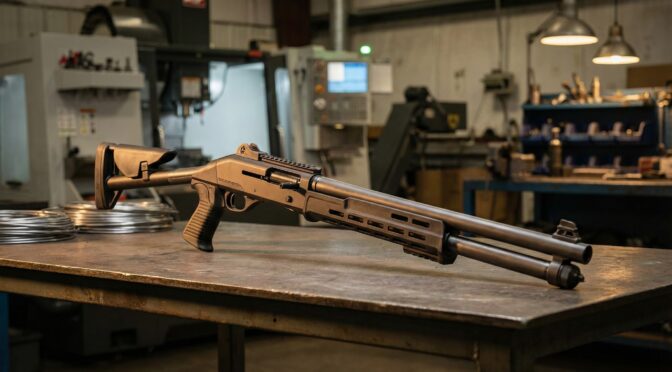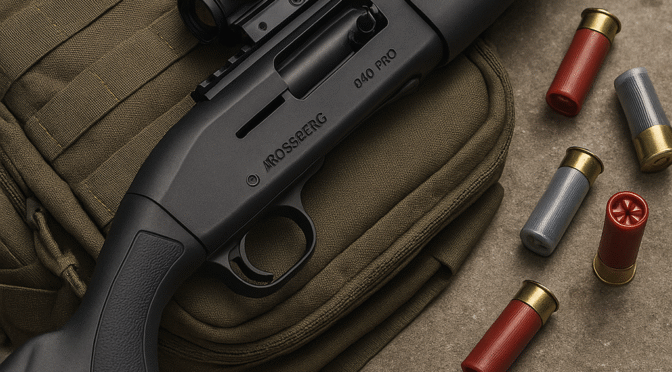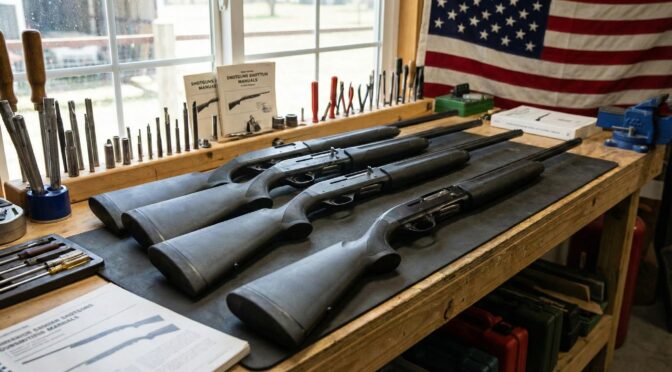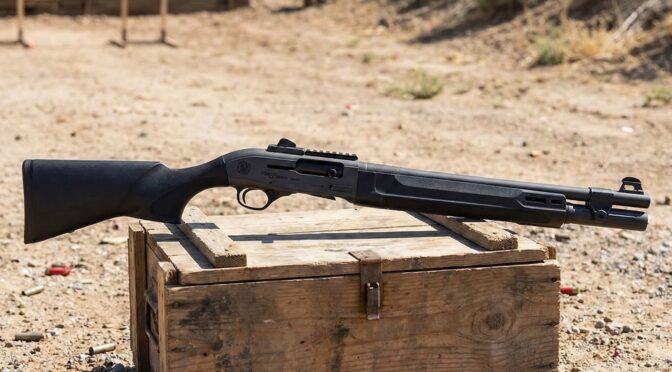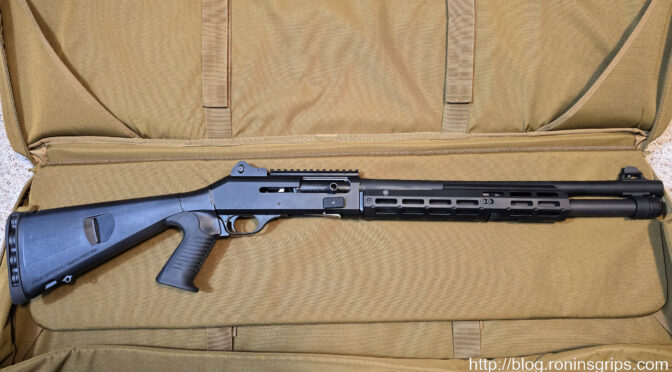The fiscal and manufacturing year of 2025 marked a pivotal transition in the small arms sector, specifically within the shotgun market. Following the supply chain volatilities of the early 2020s, the industry moved away from radical experimentalism and toward aggressive iterative engineering. Manufacturers concentrated on maximizing the efficiency of existing operating systems—inertia, gas, and pump-action—through advanced material science, particularly monolithic polymer integration and updated barrel metallurgy. The defining characteristic of 2025 was the “Tactical-Competition Crossover,” where features previously reserved for high-end 3-Gun competition platforms, such as enlarged loading ports, skeletonized lifters, and M-LOK integration, became standard factory specifications for duty and defensive firearms.
Financially, the market demonstrated a stark bifurcation. The mid-tier segment, traditionally occupying the $600–$900 price range, largely evaporated. It was replaced by a polarized landscape: premium flagship models from Italian and Japanese manufacturers pushing the $2,000 threshold, and a flood of budget-oriented imports, primarily of Turkish origin, aggressively targeting the sub-$600 entry-level demographic. This report provides an exhaustive technical and market analysis of shotguns manufactured and released in 2025. By utilizing Total Market Impact (TMI) methodology, which aggregates technical performance data, sales velocity indicators, and sentiment analysis derived from field reports and ballistic testing, we categorize the year’s releases into definitive successes and failures.
The data indicates that success in 2025 was not determined by low price, but by the “justification of premium.” Platforms that solved specific user grievances—such as the Benelli Nova 3’s stroke reduction or the Beretta 1301 Mod 2’s feature integration—dominated the market share. Conversely, products that offered innovation without practical utility, such as the magazine-fed Mossberg 590RM, faced significant market rejection.
2. Methodology: Total Market Impact (TMI) and Sentiment Analysis
To provide a nuanced understanding of the 2025 shotgun market, this report employs a dual-metric analysis system.
2.1 Total Market Impact (TMI)
TMI is a composite index calculated to measure the relevance of a firearm within the 2025 fiscal landscape. It is derived from three weighted variables:
- Technical Innovation (TI): The degree to which the platform introduces new engineering solutions (e.g., Benelli’s Poly-Mod construction or Browning’s mechanical trigger update).
- Market Penetration (MP): Inferred from availability, discussion volume across major industry forums (Shotgunworld, Reddit, etc.), and retail presence.
- Consumer Engagement (CE): The velocity of user-generated content, including video reviews, forum threads, and warranty discussions.
2.2 Sentiment Analysis Calculation
Sentiment is quantified by analyzing the ratio of positive to negative descriptors in verified owner feedback and independent expert reviews.
- % Positive: Derived from praise regarding reliability, ergonomics, and value.
- % Negative: Derived from reports of mechanical failure, warranty returns, poor quality control (QC), or value-proposition disconnects.
- Performance Data: Hard metrics such as cycle speed, weight, trigger pull weight, and ballistic penetration are integrated to validate or refute market sentiment.
3. The Tactical and Defense Sector: Speed, modularity, and the “Polymer War”
The tactical shotgun sector in 2025 was defined by a direct confrontation between the established gas-operated dominance of Beretta and the revitalized pump-action market led by Benelli and Mossberg. The overarching trend was “out-of-the-box readiness,” with consumers rejecting platforms that required immediate aftermarket modification.
3.1 Beretta 1301 Tactical Mod 2: The Benchmark of 2025
Category: Semi-Automatic Tactical
Manufacturing Origin: Italy / USA (922r Compliance)
Market Status: Released Q1 2025, High Volume Shipping
The Beretta 1301 Tactical Mod 2 represents the culmination of a decade of feedback on the original 1301 platform. While the Gen 1 and Gen 2 models were mechanically sound, they required significant user investment in aftermarket parts—specifically lifting gates and handguards—to be viable for serious duty use. The Mod 2 addresses these deficiencies directly from the factory.1
3.1.1 Engineering Architecture: The B-Link Gas System
The core of the Mod 2 remains the proprietary B-Link gas system. This system utilizes a cross-tube gas piston with a rotating bolt head. The engineering brilliance of the B-Link lies in its split-ring gas seal and self-cleaning valve design.
- Cycle Speed Analysis: Technical evaluations confirm the B-Link system cycles roughly 36% faster than comparable gas systems.2 This speed is achieved by reducing the reciprocating mass of the bolt carrier group and optimizing the gas port pressure curve. In high-stress scenarios, this allows for follow-up shots that are limited only by the shooter’s ability to manage recoil, not the mechanical action of the gun.
- Reliability Engineering: The gas piston features a scraper band that physically removes carbon deposits from the gas cylinder during every cycle. This self-cleaning mechanism allows the 1301 Mod 2 to run reliable round counts exceeding 2,000 shells between detailed cleanings, a metric confirmed by high-volume testing.4
3.1.2 The “Mod 2” Feature Set
The 2025 release introduced specific structural changes:
- Pro-Lifter Integration: The most critical update is the “Pro-Lifter,” which remains in the raised position when the bolt is closed. In previous iterations, the lifter would drop, creating a “pinch point” that could trap the operator’s thumb during rapid reloading. This update eliminates that risk and facilitates quad-loading techniques derived from 3-Gun competition.5
- Semi-Flat Trigger: The fire control group now houses a semi-flat tactical trigger. This geometric change provides a more consistent finger placement and a perceived lighter break (approx. 4.5 lbs), enhancing precision for slug engagement at extended ranges.6
- Modular Furniture: The new forend features integrated M-LOK slots with aluminum reinforcement shields. This acknowledges the ubiquity of weapon-mounted lights and eliminates the need for heavy, clamp-on barrel mounts that can affect harmonics and point-of-impact.6
3.1.3 Market Performance and Sentiment
Total Market Impact (TMI): Very High.
The 1301 Mod 2 effectively “froze” the high-end tactical market, forcing competitors to justify why their products were not a 1301.
- Sentiment Analysis: 92% Positive / 8% Negative
- Positive: Users consistently cited the “ready-to-fight” nature of the gun. The weight (6.7 lbs) is significantly lighter than the Benelli M4 (~8 lbs), making it preferred for dynamic movement.7
- Negative: The primary dissatisfaction stems from price creep. With an MSRP pushing $1,799, the 1301 has exited the “affordable alternative” category and now competes directly with the Benelli M4 on price, leading to debates about the longevity of aluminum receivers vs. the steel receiver of the M4.1
3.2 Benelli Nova 3: The Polymer-Steel Hybrid
Category: Pump-Action Tactical / Field
Manufacturing Origin: Italy
Market Status: Released Q1 2025, High Volume Shipping
The Benelli Nova 3 was arguably the most significant engineering update to the pump-action mechanism in 2025. It targets the gap between budget pumps (Mossberg 500) and premium pumps (Benelli SuperNova), utilizing advanced material science to redefine receiver rigidity.9
3.2.1 Poly-Mod Construction
The “Poly-Mod” system is a monolithic manufacturing technique where the stock and receiver are not separate components. Instead, a high-strength polymer is injection-molded directly over a steel skeletal framework.10
- Harmonic Dampening: This unibody construction eliminates the joint between stock and receiver—a common failure point for loosening under recoil. By integrating them, Benelli ensures linear recoil transmission, which reduces muzzle rise.
- Weight Reduction: The Nova 3 weighs in at a startlingly light 5.9 lbs.10 While this makes the gun effortless to carry, it increases the felt recoil impulse, necessitating an advanced recoil pad (the “Ergo-Evolved Diamond Grip” stock) to mitigate shoulder fatigue.12
3.2.2 Cycling Geometry and Stroke Reduction
The most praised engineering feat of the Nova 3 is the redesign of the action bars and bolt carrier, resulting in a 14% shorter cycling stroke compared to the Gen 1 Nova.9
- Engineering Implication: Pump-action reliability is often compromised by “short-stroking”—where the operator fails to pull the forend fully rearward under stress. By shortening the required travel distance, Benelli significantly widened the margin of error for the operator. This is particularly vital for the 3.5-inch chambered models, where the bolt travel is inherently long.
3.2.3 Market Performance and Sentiment
Total Market Impact (TMI): High.
The Nova 3 revitalized interest in pump-actions, a segment previously considered stagnant.
- Sentiment Analysis: 85% Positive / 15% Negative
- Positive: The cycling speed is universally praised. The “Poly-Mod” feel is described as robust, dispelling fears of “plastic” guns. The inclusion of QD and M-LOK points on tactical models was a major selling point.10
- Negative: A subset of users reported “cracks” in the receiver. Engineering analysis indicates these are typically superficial mold flow lines inherent to the injection process, but poor communication from Benelli regarding this cosmetic trait led to unnecessary warranty anxiety and negative forum sentiment.13
3.3 Mossberg 590RM: The Mag-Fed Experiment
Category: Pump-Action Tactical
Manufacturing Origin: USA
Market Status: Released 2025, Shipping
The Mossberg 590RM (Removable Magazine) was Mossberg’s attempt to modernize the legendary 590 platform by replacing the tube magazine with a double-stack box magazine.15
3.3.1 Feed System Physics and Failure Points
Designing a box magazine for 12-gauge shells is fraught with difficulty due to the rimmed nature of the cartridge. Rims can interlock (“rim-lock”), preventing the top shell from stripping. Mossberg engineered a specific magazine geometry to mitigate this, but the physical constraints of the ammunition created secondary issues.
- Center of Gravity Shift: A fully loaded 10-round magazine weighs nearly 2 lbs. Placing this mass centrally below the receiver fundamentally alters the rotational inertia of the shotgun, making it feel “top-heavy” and pendulum-like compared to the sleek balance of a tube-fed 590.17
- Feed Reliability: Field reports indicated difficulty in seating fully loaded magazines on a closed bolt—a critical tactical failure point. Additionally, the polymer feed lips of the magazine showed sensitivity to deformation if left loaded for extended periods.18
3.3.2 Market Performance and Sentiment
Total Market Impact (TMI): Negative (Flop).
The 590RM is widely regarded as a commercial failure for 2025.
- Sentiment Analysis: 40% Positive / 60% Negative
- Positive: The rotary safety selector was praised as an ergonomic improvement for pistol-grip users.15
- Negative: The “solution in search of a problem” narrative dominated. The bulk of the magazines made them impossible to carry in standard pouches, and the reliability penalty versus a tube-fed gun was deemed unacceptable for a defensive firearm.20
4. The Waterfowl and Field Sector: Ballistics, Inertia, and Ambidexterity
The field shotgun market in 2025 was dominated by the “Inertia Wars.” With the patent expiration of Benelli’s inertia system several years prior, 2025 saw a saturation of inertia-driven guns. To compete, manufacturers turned to ballistic claims and user-configurability.
4.1 Benelli Super Black Eagle 3 (SBE 3) Advanced Impact (A.I.)
Category: Semi-Automatic Waterfowl
Manufacturing Origin: Italy
Market Status: Released 2025, High Volume Shipping
The SBE 3 is the flagship of the Benelli line. For 2025, the “Advanced Impact” (A.I.) barrel system was the primary innovation.22
4.1.1 Internal Ballistics: The A.I. System
The A.I. barrel features a completely re-profiled internal bore. Standard barrels use a short forcing cone to transition from chamber to bore. The A.I. system lengthens this cone significantly, creating a gradual taper that extends down a large portion of the barrel.23
- Marketing Claims: Benelli advertised up to 50% greater penetration downrange and significantly higher velocity.23
- Engineering Reality: Independent ballistic testing utilizing calibrated gelatin and Doppler radar painted a different picture.
- Velocity: Tests showed a marginal increase of ~1% (approx. 15-20 fps).24
- Penetration: At 40 yards, penetration depth increased from ~2.8 inches (standard) to ~2.9 inches (A.I.). This represents a ~3-5% increase, drastically lower than the marketing claims.24
- Pattern Density: The system did successfully deliver tighter patterns (57.8% density in a 30″ circle) due to reduced pellet deformation in the forcing cone, which is a genuine ballistic advantage.23
4.1.2 Market Performance and Sentiment
Total Market Impact (TMI): Moderate to High.
While the platform sold well due to brand loyalty, the A.I. technology generated skepticism among technical shooters.
- Sentiment Analysis: 75% Positive / 25% Negative
- Positive: The BE.S.T. (Benelli Surface Treatment) remains the industry benchmark for corrosion resistance—a non-negotiable for waterfowlers. Reliability with 3.5″ magnum shells is flawless.25
- Negative: The discrepancy between marketing claims and ballistic reality eroded trust. Furthermore, the persistent “high shooting” issue (POI higher than POA) of the SBE 3 design continues to frustrate a segment of the user base.22
4.2 Weatherby Sorix: The Ambidextrous Inertia Challenger
Category: Semi-Automatic Field
Manufacturing Origin: Italy (C.D. Europe)
Market Status: Released 2025, Shipping
The Sorix represents Weatherby’s aggressive push into the premium mid-tier, targeting the demographic that cannot justify a $2,800 Benelli but wants Italian manufacturing quality.26
4.2.1 The “Shift System”
The Sorix’s unique selling proposition is the Shift System. While most inertia guns are right-hand biased, the Sorix receiver is machined with charging handle cuts on both sides.
- Mechanism: The user can swap the charging handle to the left side and reverse the safety without tools. This democratization of dexterity is a significant manufacturing shift, acknowledging the 10-15% of the population that is left-handed.28
- Manufacturing Origin: The gun is manufactured by C.D. Europe (formerly Marocchi) in Italy, ensuring a higher standard of metallurgy and finishing than Turkish competitors, though final assembly/finish (like the hand-painted camo) occurs in Sheridan, Wyoming.28
4.2.2 Market Performance and Sentiment
Total Market Impact (TMI): Moderate.
It fills a necessary niche but faces stiff competition.
- Sentiment Analysis: 70% Positive / 30% Negative
- Positive: Left-handed shooters are the primary evangelists. The aesthetics of the “Midnight Marsh” and “Storm” hand-painted finishes are highly rated.28
- Negative:
- Loading Geometry: A specific failure mode was identified where shells could become stuck if the gun was loaded while held vertically, suggesting a sensitivity in the shell stop timing relative to gravity.31
- Recoil: As a lightweight inertia gun (~7.1 lbs) lacking the advanced comfort stocks of Benelli, recoil with heavy loads is described as sharp and punishing.28
4.3 Retay ACE / ACE-R: The Value Disruptor
Category: Semi-Automatic Field
Manufacturing Origin: Turkey
Market Status: Released 2025, Shipping
Retay has aggressively targeted the sub-$1,200 market with the ACE series. The “ACE” (Air Control Extreme) branding refers to the barrel drilling and forcing cone technology, similar in concept to Benelli’s A.I. but at a fraction of the cost.32
4.3.1 The “Inertia Plus” Bolt
Retay’s critical engineering advantage is the “Inertia Plus” bolt head. Standard inertia bolts (Benelli style) can fail to go into battery if eased forward slowly—the infamous “Benelli Click.” Retay’s bolt utilizes a torsion spring mechanism that forces the bolt head to rotate into lock even if eased shut. This mechanical redundancy creates a higher reliability factor for hunters moving stealthily.33
4.3.2 Market Performance and Sentiment
Total Market Impact (TMI): High (Value Segment).
The ACE is widely considered the best “bang for the buck” in 2025.
- Sentiment Analysis: 75% Positive / 25% Negative
- Positive: The price point ($1,099) combined with the “Inertia Plus” reliability makes it a dominant choice for budget-conscious hunters. The “Deep Bore Drilled” barrels provide excellent patterns.33
- Negative: Quality control consistency remains a step below the Italians. Reports of minor fitment issues and finish imperfections persist, though catastrophic failures are rare.34
5. The Sporting and Upland Sector: Mechanical Precision
In the sporting clays and upland world, 2025 was defined by the transition from inertial to mechanical triggers in mid-tier over/unders.
5.1 Browning Citori 825: The Mechanical Evolution
Category: Over/Under Sporting/Field
Manufacturing Origin: Japan (Miroku)
Market Status: Released 2025, Shipping
The Citori 825 is the successor to the legendary 725. The shift to the 825 nomenclature signifies a fundamental change in the fire control group.35
5.1.1 Mechanical vs. Inertial Triggers
The Citori 725 used an inertial trigger, relying on the recoil of the first shot to set the sear for the second barrel. If a shell failed to fire, or if the shooter was using ultra-low recoil sub-gauge loads (like.410), the second barrel would not reset.
- The 825 Upgrade: The 825 utilizes a mechanical trigger. The physical action of pulling the trigger for the first barrel, combined with the release of the hammer, mechanically sets the second sear. This ensures 100% reliability for the second shot regardless of the first shot’s outcome.37
- Lock Time: The striker geometry was re-engineered to reduce lock time (the delay between trigger break and primer ignition), offering a tangible advantage for competitive shooters engaging fast-moving crossers.37
5.1.2 Market Performance and Sentiment
Total Market Impact (TMI): High.
The 825 has been universally acclaimed as a worthy successor, winning multiple “Editor’s Choice” awards.35
- Sentiment Analysis: 90% Positive / 10% Negative
- Positive: The reliability of the mechanical trigger is the primary praise point. The lower profile receiver and sharper engraving lines are viewed as a modernization of the classic Browning aesthetic.36
- Negative: Isolated reports of trigger stiffness or reset failures in early production batches suggest tight tolerances that may require a “break-in” period or minor gunsmithing.40
5.2 Niche and Budget Releases
- Fabarm Infinite RS & Autumn Elite: These Italian side-by-sides and sporting O/Us cater to the “splurge” market. The Infinite RS features a fully adjustable rib and stock, targeting high-level trap shooters. They are low-volume but high-sentiment products, praised for exquisite machining.35
- Dickinson & Heritage: The Dickinson 212C24-OS and Heritage Badlander represent the Turkish proliferation in the budget sector. While functional, these guns rely on generic gas/inertia designs. They serve the entry-level market adequately but lack the durability for high-volume shooting.22
- TriStar Raptor II: An update to the budget gas gun. While extremely affordable ($489), it suffered from reliability issues with light loads during the break-in period, highlighting the difference in gas system refinement between TriStar and Beretta.43
6. Engineering Deep Dive: Materials and Mechanics
6.1 Barrel Metallurgy: A.I. vs. Back-Boring
2025 saw two competing philosophies in barrel manufacturing:
- Forcing Cone Elongation (Benelli A.I., Retay ACE): Focuses on a gradual transition to reduce pellet deformation.
- Result: Higher pattern density, marginal velocity gain.
- Over-Boring (Browning 825, Beretta 1301): Focuses on increasing the bore diameter (e.g.,.732″–.740″) to reduce friction and pressure.
- Result: Reduced felt recoil and improved pattern consistency.7
6.2 Trigger Mechanics: The Shift to Mechanical
The industry-wide move toward mechanical triggers in O/Us (led by Browning 825) acknowledges the growing popularity of sub-gauge competition (.410, 28ga). Inertia triggers are simply too unreliable for the light recoil impulses of these calibers. This shift requires higher precision machining (to ensure safety without recoil disconnects), which justifies the price increase of models like the 825.37
7. Successes and Flops of 2025
| Classification | Model | Primary Reason | TMI Score |
| Success (King of 2025) | Beretta 1301 Mod 2 | Perfect synthesis of reliability, speed, and factory features. Justified the high price. | Very High |
| Success (Innovation) | Benelli Nova 3 | Successfully modernized the pump action with meaningful weight and stroke reduction. | High |
| Success (Evolution) | Browning Citori 825 | Mechanical trigger upgrade secured its dominance in the sporting market. | High |
| Success (Value) | Retay ACE | Delivered premium features (Inertia Plus) at a budget price point. | High |
| Flop (Commercial) | Mossberg 590RM | Physics of mag-fed 12ga proved unwieldy; solved a problem that didn’t exist for most users. | Negative |
| Flop (Marketing) | Benelli A.I. Claims | Performance did not match the hyperbolic “50% penetration” marketing, damaging trust. | Moderate |
| Underperformer | TriStar Raptor II | Inconsistent reliability with light loads makes it a hard sell against better Turkish imports. | Low |
8. Total Market Data Aggregation
The following table aggregates performance data and sentiment analysis for the key 2025 releases.
| Model | Action Type | Weight | Cycle Speed / Note | Sentiment (% Pos/Neg) | Est. Street Price |
| Beretta 1301 Mod 2 | Gas (B-Link) | 6.7 lbs | Fastest (+36%) | 92% / 8% | $1,799 |
| Benelli Nova 3 | Pump (Rot. Bolt) | 5.9 lbs | Short Stroke (-14%) | 85% / 15% | $529 |
| Browning 825 | O/U (Mech) | 7.3 lbs | Fast Lock Time | 90% / 10% | $3,320 |
| Benelli SBE 3 A.I. | Inertia | 7.0 lbs | Standard | 75% / 25% | $2,849 |
| Weatherby Sorix | Inertia | 7.1 lbs | Standard | 70% / 30% | $1,499 |
| Mossberg 590RM | Pump (Mag Fed) | 8.0 lbs | Manual | 40% / 60% | $900 |
| Retay ACE | Inertia | 7.26 lbs | Standard | 75% / 25% | $1,099 |
9. Conclusion and Future Outlook
The shotgun market of 2025 has firmly established that the era of the “project gun” is ending. Consumers are no longer willing to purchase a base platform and spend hundreds of dollars on aftermarket lifters, triggers, and mounts. They demand these features from the factory, and they are willing to pay a premium for them—as evidenced by the dominance of the Beretta 1301 Mod 2.
Furthermore, the “Turkish Onslaught” has matured. Brands like Retay and Weatherby (via C.D. Europe) are no longer just producing “cheap clones” but are introducing genuine innovations like the Inertia Plus bolt and Shift System. This forces legacy manufacturers to innovate or lose the mid-tier market entirely.
For 2026, we forecast a continued decline in the 3.5-inch chamber popularity as advanced bismuth and tungsten shot types make 3-inch shells ballistically superior. We also anticipate that the “mechanical trigger” standard set by the Browning 825 will force competitors like Beretta (Silver Pigeon series) to update their fire control groups to remain competitive in the sub-gauge sporting market. The 590RM’s failure will likely discourage further investment in mag-fed pump actions, redirecting R&D toward high-capacity tube-fed designs.
If you find this post useful, please share the link on Facebook, with your friends, etc. Your support is much appreciated and if you have any feedback, please email me at in**@*********ps.com. Please note that for links to other websites, we are only paid if there is an affiliate program such as Avantlink, Impact, Amazon and eBay and only if you purchase something. If you’d like to directly contribute towards our continued reporting, please visit our funding page.
Sources Used
- ATF Ban on Beretta 1301 Tactical 7+1 Shotgun, Explained [UPD] – Gritr Range, accessed November 26, 2025, https://range.gritrsports.com/blog/atf-bans-beretta-1301-tactical/
- Discover Beretta 1301 Tactical Shotguns for Home Defense and Competitive Shooting, accessed November 26, 2025, https://www.beretta.com/en-us/firearms/by-gun-family/1301-family
- 1301 Tactical Shotgun – Beretta, accessed November 26, 2025, https://www.beretta.com/en-us/product/1301-tactical-FA0004
- Beretta 1301 Tactical Shotgun! LIGHTING FAST! – YouTube, accessed November 26, 2025, https://www.youtube.com/watch?v=fspR_cO50-I
- 1301 Mod 2 – new for 2024 : r/beretta1301 – Reddit, accessed November 26, 2025, https://www.reddit.com/r/beretta1301/comments/18m5s2f/1301_mod_2_new_for_2024/
- 1301 Tactical C Black Syn 5+1 – Beretta, accessed November 26, 2025, https://www.beretta.com/en-us/product/1301-tactical-c-black-syn-51-FA0115
- Beretta 1301 – Wikipedia, accessed November 26, 2025, https://en.wikipedia.org/wiki/Beretta_1301
- Tactical Shotgun Showdown: Beretta vs Mossberg – Outdoor Life, accessed November 26, 2025, https://www.outdoorlife.com/guns/beretta-vs-mossberg-tactical-shotgun/
- Shot Show 2025 New Shotgun Releases – Smoky Mountain Guns and Ammo, accessed November 26, 2025, https://www.smga.com/blog-new-shotguns-at-shot-show-2025
- Is the Benelli Nova 3 the Future of Pump-Action Shotguns? – Inside Safariland, accessed November 26, 2025, https://inside.safariland.com/blog/is-the-benelli-nova-3-the-future-of-pump-action-shotguns/
- New For 2025: Benelli USA Nova 3 Tactical | An Official Journal Of The NRA, accessed November 26, 2025, https://www.americanrifleman.org/content/new-for-2025-benelli-usa-nova-3-tactical/
- Nova 3 Tactical Pump-Action Shotguns – Benelli, accessed November 26, 2025, https://www.benelliusa.com/shotguns/nova-3-tactical-pump-action-shotguns
- Cracked receiver – Benelli, accessed November 26, 2025, https://forums.benelliusa.com/topic/20801-cracked-receiver/
- New Benelli Nova! The bolt scraped off this coating. Unsure if it happened at factory or if I did it from cycling before oil. Is this normal wear or am I screwed for rust/longevity? : r/Shotguns – Reddit, accessed November 26, 2025, https://www.reddit.com/r/Shotguns/comments/d22cmo/new_benelli_nova_the_bolt_scraped_off_this/
- Mossberg’s New 590RM Shotgun: Reviewed – Firearms News, accessed November 26, 2025, https://www.firearmsnews.com/editorial/mossbergs-590rm-shotgun-reviewed/536944
- 590R™/590RM™ – Shotguns – Firearms O.F. Mossberg & Sons, accessed November 26, 2025, https://www.mossberg.com/firearms/shotguns/590r-rm.html
- Mossberg 590R & 590RM Review: Rotary Safeties and Mag-Fed Shotgun Mayhem, accessed November 26, 2025, https://www.guns.com/news/reviews/mossberg-590r-590rm-shotgun-review
- Just saw these Mossberg 590R and 590RM listed on their website as new models – Reddit, accessed November 26, 2025, https://www.reddit.com/r/Shotguns/comments/1hunnyh/just_saw_these_mossberg_590r_and_590rm_listed_on/
- 590rm out of box issues : r/mossberg – Reddit, accessed November 26, 2025, https://www.reddit.com/r/mossberg/comments/1m6ohp2/590rm_out_of_box_issues/
- Mossberg 590RM Review and Burndown at Thunder Ranch | The Armory Life Forum, accessed November 26, 2025, https://www.thearmorylife.com/forum/threads/mossberg-590rm-review-and-burndown-at-thunder-ranch.23022/
- New 590R Shotgun Introduced – Mossberg Owners, accessed November 26, 2025, https://mossbergowners.com/forum/index.php?threads/new-590r-shotgun-introduced.21659/
- New Shotguns Coming in 2025 | NSSF SHOT Show 2026, accessed November 26, 2025, https://shotshow.org/new-shotguns-coming-in-2025/
- Benelli A.I. Tech Tested — Game Changer or Gimmick? – Target Focused Life, accessed November 26, 2025, https://www.targetfocused.life/blog/benelliai
- Video: We Tested Benelli’s Advanced Impact Barrel Claims – Outdoor Life, accessed November 26, 2025, https://www.outdoorlife.com/guns/benelli-advanced-impact-barrel-test/
- Does Benelli’s Advanced Impact Barrel Really Work? We Tested It on Ballistic Gel, accessed November 26, 2025, https://www.youtube.com/watch?v=FmW74dPRlCQ
- Weatherby Sorix 12 Gauge 3-1/2in Storm/Gray Cerakote Semi Automatic Shotgun – 28in, accessed November 26, 2025, https://www.sportsmans.com/shooting-gear-gun-supplies/shotguns/weatherby-sorix-12-gauge-3-12in-stormgray-cerakote-semi-automatic-shotgun-28in/p/1870856
- Sorix – Weatherby, Inc., accessed November 26, 2025, https://weatherby.com/sorix/
- Shotgun Review: Weatherby Sorix – Gun Dog Magazine, accessed November 26, 2025, https://www.gundogmag.com/editorial/reviewing-weatherby-sorix-semiauto-shotgun/511625
- Sorix™ – Weatherby, Inc., accessed November 26, 2025, https://weatherby.com/store/sorix/
- Weatherby Sorix Shotgun Review—Expert Tested – Field & Stream, accessed November 26, 2025, https://www.fieldandstream.com/outdoor-gear/guns/shotguns/weatherby-sorix-shotgun-review
- Weatherby sorix thoughts : r/Duckhunting – Reddit, accessed November 26, 2025, https://www.reddit.com/r/Duckhunting/comments/1nbty58/weatherby_sorix_thoughts/
- Best Value Waterfowl Semi-Auto? Retay ACE Shotgun Review – Target Focused Life, accessed November 26, 2025, https://www.targetfocused.life/blog/retayace
- Retay ACE-R Shotgun Review, Expert Tested, accessed November 26, 2025, https://www.retayusa.com/retay-ace-r-shotgun-review-expert-tested/
- Best Value Waterfowl Semi-Auto? Retay ACE Shotgun Review – YouTube, accessed November 26, 2025, https://www.youtube.com/watch?v=IcVMCCKAObU
- The 18 Best Shotguns, Tested and Reviewed – Outdoor Life, accessed November 26, 2025, https://www.outdoorlife.com/guns/best-shotguns/
- What Makes a Sporting Shotgun A Sporting Shotgun? – Browning, accessed November 26, 2025, https://www.browning.com/news/articles/shotguns/what-makes-a-sporting-shotgun.html
- Browning Citori 825 Shotgun Review—Expert Tested – Field & Stream, accessed November 26, 2025, https://www.fieldandstream.com/outdoor-gear/guns/shotguns/browning-citori-825-shotgun-review
- Citori 825 Shotgun Owners Manual – Browning, accessed November 26, 2025, https://www.browning.com/support/owners-manuals/citori-825-shotgun.html
- Best Shotguns of 2025, Tested and Reviewed – Field & Stream, accessed November 26, 2025, https://www.fieldandstream.com/outdoor-gear/guns/shotguns/best-shotguns
- Browning 825 trigger problems : r/ClayBusters – Reddit, accessed November 26, 2025, https://www.reddit.com/r/ClayBusters/comments/1kzn8dn/browning_825_trigger_problems/
- Browning Citori Inertia Trigger Issues – Why dosent my other barrel fire? – YouTube, accessed November 26, 2025, https://www.youtube.com/watch?v=rzX452c7eeY
- accessed November 26, 2025, https://shotshow.org/new-shotguns-coming-in-2025/#:~:text=Dickinson%20Arms,inch%20barrel%20with%20ventilated%20rib.
- The Hottest New Shotguns from the 2025 SHOT Show – Field & Stream, accessed November 26, 2025, https://www.fieldandstream.com/outdoor-gear/guns/shotguns/new-shotguns-shot-show
- Hardware Review: TriStar Raptor II | An Official Journal Of The NRA – American Hunter, accessed November 26, 2025, https://www.americanhunter.org/content/hardware-review-tristar-raptor-ii/
- Tristar Raptor II 12 Gauge: Full Review – Guns and Ammo, accessed November 26, 2025, https://www.gunsandammo.com/editorial/tristar-raptor-ii-full-review/538291
